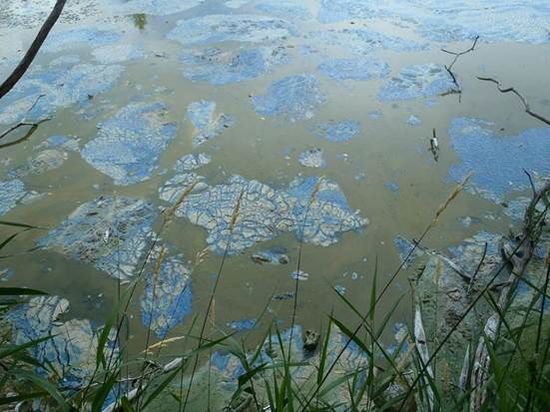Blue Green Algae
Dorothy feels that Blue Green Algae is a potential concern. Here are her comments.
The Minnesota Pollution Control Agency posted blue-green algae warnings for the state during the summer of 2016; algal blooms were early that year due to the rain and hot weather. The algae is pretty toxic; it has killed swimming dogs within minutes. Here is an article. The picture below shows what the algae looks like. (However, note that this isn't a picture from Silver Lake).
We have had blue-green on Silver Lake in the past most summers when tested, as noted in the 2008 Watershed District Report On Lake Health. Lake survey results for 1996, 2000 and 2005 were analyzed to determine the composition and abundance of phytoplankton in Silver Lake. Blue-green algae was especially dominant in 2000 and 2005. In 1996 and 2000, the blue-green algae peaked in early August, but peaked in late August in 2005. The 1996, 2000, and 2005 results are summarized in Figures SI-4, SI-5 and SI-6.
Green algae are edible to zooplankton and serve as a valuable food source. Blue-green algae are considered a nuisance type of algae because they:
- Are generally inedible to fish, waterfowl, and most zooplankters,
- Float at the lake surface in expansive algal blooms,
- May be toxic to animals when occurring in large blooms, and
- Can disrupt lake recreation because they are most likely to be present during the
summer months.
Blue-green and green algal growth is stimulated by excess phosphorus loads. The growing conditions during July and August are particularly favorable to blue-greens, and they have a competitive advantage over the other algal species during this time. However, the phytoplankton populations profiled in 1996 and 2005 do show the green algae surviving in significant numbers throughout the period when blue-green algae normally outcompetes the green algae, decimating the green algae population.
Marc is the only resident who regularly swims in Silver Lake. He appreciates this information, but isn't overly concerned about the impact on swimming. Blue green algae is toxic, but one only really gets a harmful dose if one drinks water with the algae scum. As noted above, it is a particular concern to dogs.
